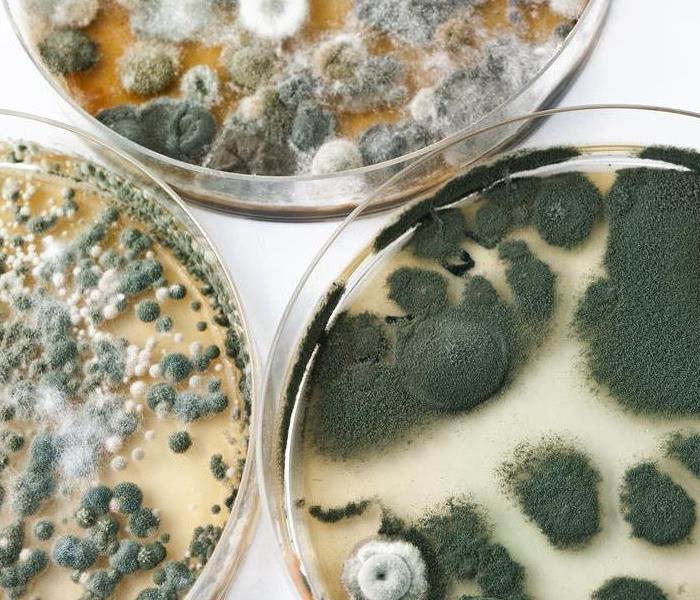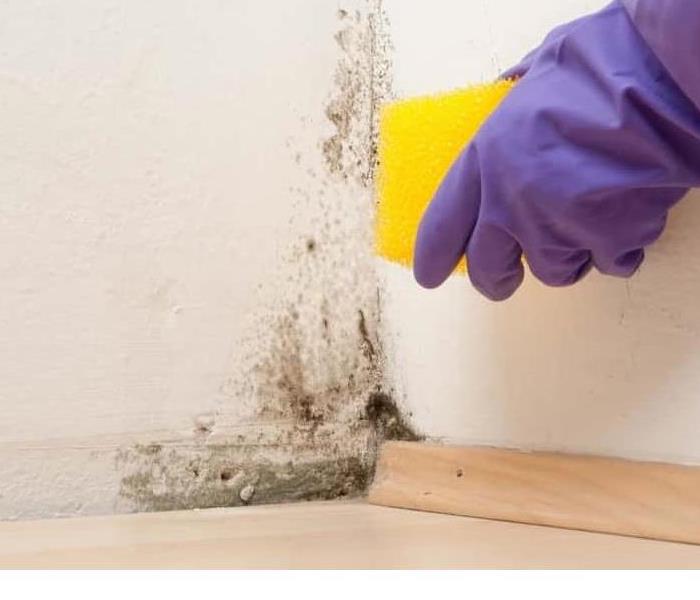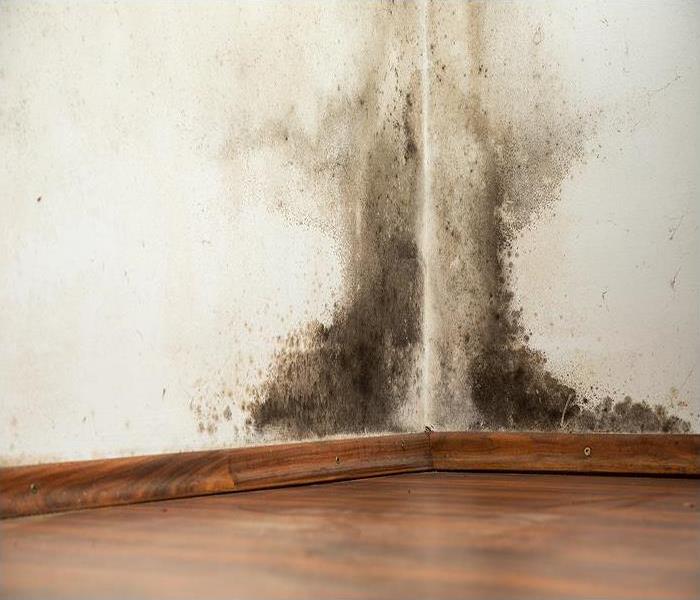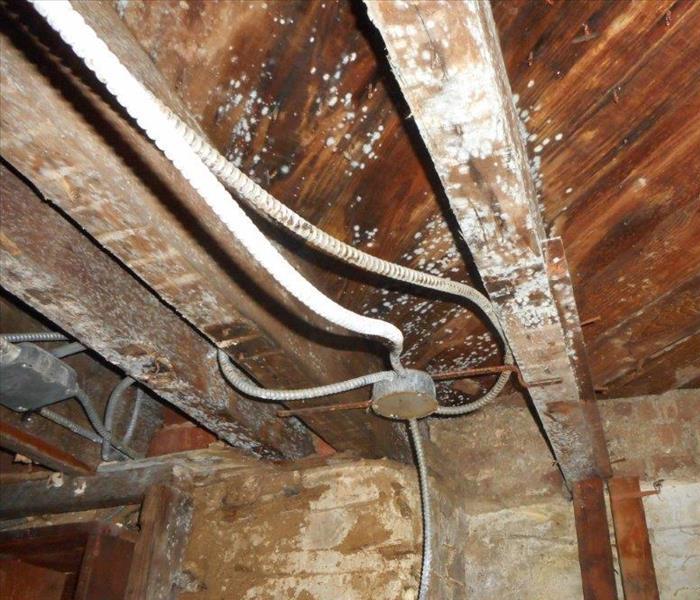Recent Mold Remediation Posts
What Causes Mold Inside The Home?
4/19/2018 (Permalink)
 SERVPRO of Southwest Brooklyn has a team of trained specialists to handle any mold removal projects.
SERVPRO of Southwest Brooklyn has a team of trained specialists to handle any mold removal projects.
Mold needs saturation or water to prosper. Mold spores will start spreading as soon as they find a wet surface. Some fundamental spots mold can cover include:
- Bathrooms. Showers, sinks, and toilets are perfect areas for mold. These spots tend to be soggy and, without powerful ventilation, will grow mold.
- Air conditioning and vents.
- Fireplaces. When not frequently in use, a chimney or fireplace is dark and cool—a productive ground for mold spore growth.
- Attics. On the off chance that your roof cracks, mold can reproduce and spread through the ventilation space in the regularly disregarded room. It will flourish in ventilation or soffit vents.
- Cellars. That obvious basement smell is confirmation of moisture and—more than likely—mold. Mold will be found encompassing the foundation, sump pump, windows, or vents.
Indoor mold progression must be ceased by drying the clammy conditions inside. In the event that there is mold proliferation in your home it is fundamental to stop it quickly. In the wrong conditions mold can spread quickly—in as meager as 24–48 hours.
If you are uncertain if your home or business has mold it is fundamental that you call a pro as fast as possible. They will begin by dissecting and testing the territory. The Mold Remediation Specialists at SERVPRO of Southwest Brooklyn are knowledgeable about water and mold removal. They're professionals in recovering your home from mold, utilizing the best possible gear.
SERVPRO of Southwest Brooklyn specialists will survey the damage and, if required by law, get a protocol for a Certified Mold Assessor so they can start to devise a strategy. They will then spotlight the issue and get to work. Utilizing blockades and a negative air pressure chamber, your SERVPRO of Southwest Brooklyn professional will stop the mold so they can begin cleaning and restoring your home.
The specialists at SERVPRO of Southwest Brooklyn are thoroughly trained for remediation, guaranteeing your home or business will be yours again in no time.
SERVPRO of Southwest Brooklyn offers a fast reaction 24 hours per day, every day of the week.
Is Black Mold Really Dangerous?
4/2/2018 (Permalink)
 SERVPRO of Southwest Brooklyn has a team of trained mold removal & mold remediation experts.
SERVPRO of Southwest Brooklyn has a team of trained mold removal & mold remediation experts.
We’ve all been there. You go into your basement or your bathroom and there, on the wall, you see it: black mold. You panic, because you’ve heard horror stories for years about the dangers of black mold, but is there really any truth to the hype?
In truth, the term “toxic black mold” is a misnomer with no scientific validation at all. In fact, the term “toxic mold” is also inaccurate. According to the CDC, “the term ‘toxic mold’ is not accurate. While some molds can produce toxins, specifically mycotoxins, the molds themselves are not toxic or poisonous”.
So what kinds of mycotoxins can black mold produce? The trichothecene types below are found in toxic black mold:
- Cyclosporin
- Roridin E
- Satratoxin F, G and H (the most abundant type of trichothecene)
- Sporidesmin G
- Stachybotryolactone
- Trichoverrol
- Trichoverrin
- Verrucarin J
Molds come in a rainbow of colors but it is the black mold species Stachybotrys chartarum that has been falsely dubbed “toxic black mold”. In reality, mold is everywhere in our environment, it’s the dosage that makes the poison.
There is no argument that excessive exposure to almost any type of mold can cause adverse health effects, no matter what the color.
In addition, mold growth can also damage buildings—weakening structure and causing unpleasant odors, as well as causing ugly staining. Cleaning mold is often exactly what causes it to spread; the process dislodges mold spores and allows them to travel into new areas of the environment.
To avoid this it’s best to call a professional when you suspect you have a mold issue in your home or business. SERVPRO of Southwest Brooklyn has years of experience in mold removal and remediation and can ensure that any damage caused by mold is repaired properly, and completely. With SERVPRO of Southwest Brooklyn it’ll be "Like it never even happened."
The Real Truth About Mold Removal And Mold Remediation
3/23/2018 (Permalink)
 SERVPRO of Southwest Brooklyn has a team of trained mold removal & mold remediation technicians to handle any job size.
SERVPRO of Southwest Brooklyn has a team of trained mold removal & mold remediation technicians to handle any job size.
Many contractors and even mold removal companies will try to confuse you as to the difference between mold removal and mold remediation. Some will try to tell you that for a small mold issue, you can get mold removal, but for a larger more dangerous issue, you’ll need a more complicated, and expensive, mold remediation. Out of fear, many will choose to go with remediation and spend the extra money. That makes sense, mold can be extremely dangerous, causing severe illness and other problems, but the fact is that mold removal and mold remediation are interchangeable terms that mean the same thing!
Mold is endemic in our environment, meaning you can find it almost everywhere that water and oxygen are present. While some mold, such as the mildew in your shower (when in small quantities,) are considered “cosmetic mold” and can be simply sprayed with bleach, other types of mold (and even mildew when it spreads,) can become dangerous and toxic.
SERVPRO of Southwest Brooklyn has certified mold remediation technicians that can not only help to identify and properly remove the mold in your home, but they will also locate the source, and eradicate the cause of your mold issues.
When you find mold in your home, make sure that your mold professional can explain the mold remediation process in simple terms. Many small mold issues should not be expensive to handle. Moldy drywall is one example. If the affected area is small, it should not be a tremendously expensive fix. The most important issue with small drywall fixes happens once the damaged section is removed. It is imperative to ensure that spores are not spread further, so great care must be taken with the disposal of affected areas. If the technicians you hire use extremely technical terms to frighten you into tremendously expensive treatment options, be wary.
When you call SERVPRO of Southwest Brooklyn, we will carefully inspect your property to ensure that not only are all mold issues are addressed, but also that we locate the source of the issue, and eradicate it. If we do find an issue that needs to be addressed, we will use specialized filtration equipment to capture microscopic mold spores that may be in the air and to prevent them from spreading during removal.
In addition to mold removal, we also specialize in cleaning your belongings and ensuring that they are sanitized and safe to use. Should major restoration need to be done, we can also handle reconstruction and finishing to ensure that you are back to normal as quickly, and cleanly, as possible.
Mold doesn’t have to be scary, so don’t let an unqualified contractor or “specialist” make it into a nightmare.
Common Places for Mold to Grow
10/20/2017 (Permalink)
 Mold can grow in many places.
Mold can grow in many places.
When we think of mold problems we equate it to damp basements and black gross mold growing on drywall; but mold is insidious and can grow in places where you least expect it. Mold is fast growing, can pop up within 24 hours of being exposed to moisture, and spreads quickly.
Here are some common places where mold forms that you might not be aware of:
The spaces behind and under your fridge rarely see the light of day, which make them a perfect breeding ground for mold. Clean all water lines and drip pans and ensure they are not leaking; even a small leak can lead to a huge mold problem. Take the extra time to check and clean behind and underneath your refrigerator.
Your chimney can easily become a breeding ground for mold. Brick crevices collect water, dirt, and other organic debris. Rusted chimney caps and faulty flashing let in rain and snow, encouraging mold to grow. Replace rusted caps and fix flashing. Call a licensed mold removal specialist to remove the mold in your chimneys. To prevent mold, get your chimney cleaned by a professional chimney sweep at least once a year.
- Front-Loading Washing Machines
Front-loading washing machines are great, but can be a hotspot for mold growth. The gasket around the door on front-loading washing machines often stays wet because the door is usually closed when not in use. Add some lint to the moisture and mold happily munches and multiplies. Wipe the gasket and glass dry before you shut the door. If you spot mold, run a hot water wash with some chlorine bleach (no clothes), which will kill the fungi. Even if you have a top-load washer make sure to regularly check behind and underneath your washer and dryer to make sure there are no leaks or source of moisture. Clean out vents and lint traps to prevent mold havens, as well as fire hazards.
Condensation from windows provides the moisture mold loves, and the dirt and dust that collect provide the perfect place for the mold to settle. After heavy rains open windows and wipe moisture from the bottoms of sashes and windowsills. Replace any broken seals and if you notice any water has leaked into the wood and walls call a professional to see if the problem has caused mold.
Air conditioning units trap dust and pollen (a good meal for mold) and grab moisture from the air. If you don’t run your AC unit at least every 24 hours in warm weather humidity in your house climbs, giving mold the opportunity to grow in AC ducts, drain pans, and on coils. Drip pans and drainage hoses on window units can leak causing mold to grow into the windowsill and dry wall. If mold grows in your central air conditioning unit you’ll have to hire a mold remediation pro to clean out the system.
If you suspect you may have mold contact the experts at SERVPRO of Southwest Brooklyn
Mold
4/29/2016 (Permalink)
 Mold inside attic.
Mold inside attic.
Microscopic mold spores naturally occur almost everywhere, both outdoors and indoors. This makes it impossible to remove all mold from a home or business. Therefore, mold remediation reduces the mold spore count back to its natural or baseline level. Some restoration businesses advertise “mold removal” and even guarantee to remove all mold, which is a fallacy. Consider the following mold facts:
- Mold is present almost everywhere, indoors and outdoors.
- Mold spores are microscopic and float along in the air and may enter your home through windows, doors, or AC/heating systems or even hitch a ride indoors on your clothing or a pet.
- Mold spores thrive on moisture. Mold spores can quickly grow into colonies when exposed to water. These colonies may produce allergens and irritants.
- Before mold remediation can begin, any sources of water or moisture must be addressed. Otherwise, the mold may return.
- Mold often produces a strong, musty odor and can lead you to possible mold problem areas.
- Even higher-than-normal indoor humidity can support mold growth. Keep indoor humidity below 45 percent.
If your home or business has a mold problem, we can inspect and assess your property and use our specialized training, equipment, and expertise to remediate your mold infestation.
If You See Signs of Mold, Call Us Today – 718-375-2388
 SERVPRO of Southwest Brooklyn has a team of trained specialists to handle any mold removal projects.
SERVPRO of Southwest Brooklyn has a team of trained specialists to handle any mold removal projects.





 24/7 Emergency Service
24/7 Emergency Service



